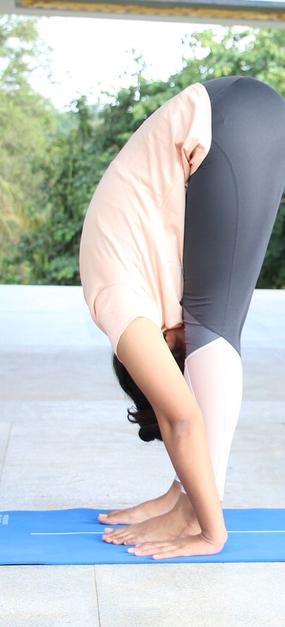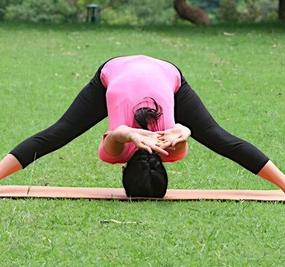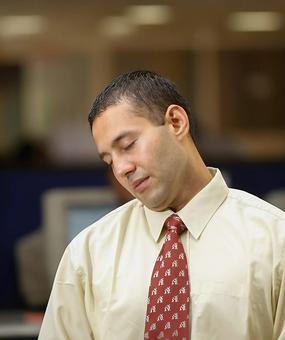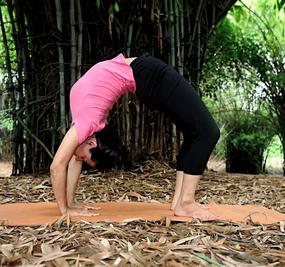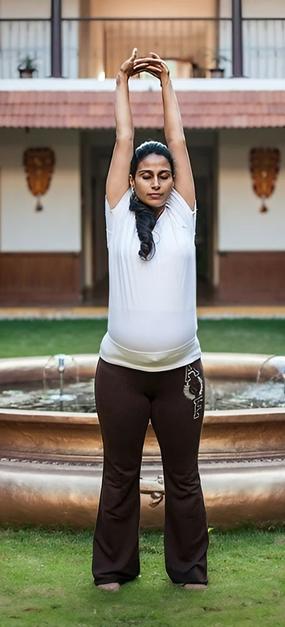Ardha= Half; Chakra= Wheel; asana= Pose
Pronounced: ardhah-chak-rah-asanah
How to do Ardha Chakrasana
- Stand straight with feet together and arms alongside the body.
- Balance your weight equally on both feet
- Breathing in, extend your arms overhead, palms facing each other.
- Breathing out, gently bend backwards pushing the pelvis forward, keeping the arms in line with the ears, elbows and knees straight, head up, and lifting your chest towards the ceiling.
- Hold. Breathing in, come back up.
- Breathing out, bring the arms down and relax.
Benefits of the Ardha Chakrasana
- Stretches the front upper torso.
- Tones the arms and shoulder muscles.
Contraindications
- Those with serious hip or spinal problems should avoid this asana as well as those with high blood pressure and brain ailments.
- Peptic or duodenal ulcers and hernia patients should avoid this pose.
- Pregnant woman should avoid this pose.
View All –Standing Yoga Asanas
Yoga practice helps develop the body and mind bringing a lot of health benefits yet is not a substitute for medicine. It is important to learn and practice yoga postures under the supervision of a trained Sri Sri Yoga teacher. In case of any medical condition, practice yoga postures after consulting a doctor and an Sri Sri Yoga teacher. Find an Sri Sri Yoga program at an Art of Living Center near you. Do you need information on programs or share feedback? Write to us at info@srisriyoga.in
All Yoga PosesPrevious yoga pose: Hastapadasana
Next yoga pose: Trikonasana
FAQ’s on Ardha Chakrasana (Standing Backward Bend)
Standing In Sanskrit Standing back bend is called Ardha Chakrasana or Anuvittasana. Also called as Half Wheel Pose.
Standing back bend yoga forms an integral part of yoga. Some of the Standing back bend yoga are: Ustrasana, Kapotasana, Urdhva Dhanurasana, Eka Pada Raja Kapotasana.
It stretches the front upper torso. It tones the arms and shoulder muscles. Balance of the body improves. It strengthens your spine and its flexibility.
Make sure you have done enough warm-up for your lower back, hip-flexor, ankles and wrists. Mark your standing position by standing in front of the wall with fully extended arms. Now turn around to have your back facing the wall. Open your legs wider than your hip-width. Curling back towards the wall little by little. Put your hands on the wallone at a time shoulder width apart. Then press the wall and slowly walk through the hands down the wall. Maintain your body-balance. When you have done that to your maximum, squuze your Abs in and tuck your tail-bone down. Once you are done with this, walk your hands up and release the back-bend. The day you are confident doing the back bend against a wall, you can start with Chakrasana too.
Standing back bend yoga forms an integral part of yoga. Some of the Standing back bend yoga are: Ustrasana, Kapotasana, Urdhva Dhanurasana, Eka Pada Raja Kapotasana.
Stand straight with feet together and arms alongside the body. Balance your weight equally on both feet Breathing in, extend your arms overhead, palms facing each other. Breathing out, gently bend backwards pushing the pelvis forward, keeping the arms in line with the ears, elbows and knees straight, head up, and lifting your chest towards the ceiling. Hold. Breathing in, come back up. Breathing out, bring the arms down and relax. Repeat the sequence a few more times.
In Sanskrit, cobra pose is called bhujangasana. It is pronounced as Bhu-jung-aahs-uh-nuh. Bhujangasana comes from the word bhujanga – cobra or snake and asana – pose. This pose is included in Suryanamaskar (Sun Salutations Pose) as well as Padma Sadhana.
Those with serious hip or spinal problems should avoid back bend asana as well as those with high blood pressure and brain ailments. Peptic or duodenal ulcers and hernia patients should avoid this pose. Pregnant woman should avoid this pose.
Usually children’s body is flexible for all beginner asanas. With help they can achieve it. Warm up by jogging or running and stretching for lower back, hip-flexor, ankles and wrists. Practice cat pose, cobra pose, downward facing dog and bridge pose as preparatory poses. Practice a backbend against a wall to build up confidence. Start with a full back bend with someone helping the kid to lift up initially. Last step is to practice standing from back bend.
First check for your body’s flexibility, for a back bend asana. If you feel you have the experience, the essential skill and a yoga expert, then you should attempt back bend asana. Learn the sequence of the asana in a day. But practice a few days to refine it. Avoid being in ahrry to achieve perfection in one go.
Beginners should make sure you have done enough warm-up for your lower back, hip-flexor, ankles and wrists. Mark your standing position by standing in front of the wall with fully extended arms. Now turn around to have your back facing the wall. Open your legs wider than your hip-width. Curling back towards the wall little by little. Put your hands on the wallone at a time shoulder width apart. Then press the wall and slowly walk through the hands down the wall. Maintain your body-balance. When you have done that to your maximum, squuze your Abs in and tuck your tail-bone down. Once you are done with this, walk your hands up and release the back-bend.



